Why did NAEP scores decline during Great Awokening?
When progressive ideas triumph, why do lower classes' test scores crater?
Overall test scores on the federal National Assessment of Educational Progress rose from 2003 through 2013, then drifted down through 2019, dropped sharply during covid school closures, then continued to decline from 2022 to 2024.
On the other hand, these are not huge changes, just a small fraction of a standard deviation. (By the way, I look at NAEP scores by averaging four tests: math and reading scores for 4th graders and 8th graders.)
As I’ve mentioned before, most of the decline during covid was among the bottom half of test-takers. White collar kids do okay going to school on Zoom, but blue collar kids benefit from going to school in person and being talked at by middle class grown-ups.
Still, their decline began back around 2015. From the New York Times news section:
The Pandemic Is Not the Only Reason U.S. Students Are Losing Ground
For years, the country’s lowest-scoring students were steadily improving on national tests. Starting around 2013, something changed.
By Sarah Mervosh
April 7, 2025
There was once a time when America’s lowest-performing students were improving just as much as the country’s top students.
Despite their low scores, these students at the bottom made slow but steady gains on national tests for much of the 2000s. It was one sign that the U.S. education system was working, perhaps not spectacularly, but at least enough to help struggling students keep pace with the gains of the most privileged and successful.
Today, the country’s lowest-scoring students are in free fall.
Top scorers shown are at the 90th percentile; lowest scorers are at the 10th. Scores are from the National Assessment of Educational Progress, which tests a national sample of students to track educational achievement. Source: NAEP By Francesca Paris
The reason is not just the pandemic. For at least a decade, starting around 2013, students in the bottom quartile have been losing ground on the National Assessment of Educational Progress, a key exam that tests a national sample of fourth and eighth grade students in math and reading.
…The bottom quartile is made up of students from various backgrounds, but it includes a higher proportion of students with disabilities, students learning English and children from poor families. Since the pandemic, their scores have often continued to fall, even as high achieving students stabilize. …
Researchers point to a number of educational and societal changes over the past decade, including a retrenchment in school accountability, the lasting effects of the Great Recession and the rise of smartphones, which has coincided with worsening cognitive abilities even among adults since the early 2010s. …
One possible explanation is the end of No Child Left Behind, the contentious school accountability law President George W. Bush signed in 2002.
The law is perhaps best known for its legacy of standardized testing, including annual exams in math and reading in third through eighth grade.
To me, it’s best known for insisting that by 2014, all public school students in the country would score at least Proficient on a scale of:
Advanced
Proficient
Basic
Below Basic
Lake Wobegon mandated by law!
But, at least it was a different era than the succeeding Great Awokening.
Paywall below.
But it also put a sharp focus on low performers, part of Mr. Bush’s campaign against what he called “the soft bigotry of low expectations” in public schools. The law set a goal of having all students reach proficiency.
See, I’m not making this up about how the mighty intellects of George W. Bush and Ted Kennedy got together and decided that all students must be above average within 12 years.
But it was a pretty centrist era dominated by overly-optimistic billionaires like Bill Gates. The billionaires were annoying back then, but they were better than Ibram X. Kendi as the intellectual giant of the era.
Schools were required to break out testing data by race, income and special education status, and schools that did not show progress could face penalties.
It corresponded with a period of rapid improvement in test scores, particularly in math. Reading scores also improved, though more modestly.
The biggest increases were for students at the bottom.
But the law was also deeply unpopular on the left and the right.
But eventually, the Education Reform Era failed to Close the Gap, so opinion changed during the Great Awokening to hopelessness about closing the racial gap in performance combined with optimism that you could guilt-trip white people into giving their children’s jobs and money away by constantly libeling their ancestors and themselves, such as by lowering standards.
Not surprisingly, that didn’t do the lower classes much good.
Critics argued it was too punitive, with unrealistic goals. Many said it led a “drill and kill” culture of teaching to the test, leaving less time for other important subjects like social studies and the arts.
By the early 2010s, states had gotten waivers from the law, and in 2015, the Every Student Succeeds Act returned power to the states, which in many cases led to more relaxed accountability. …
Some states, especially a few in the South, most famously forlorn Mississippi, have worked hard to come up with more realistic ideas for schooling, such as an emphasis on learning to read through phonics and holding back illiterate 3rd graders for an additional year of phonics instruction.
Mississippi’s lowest-scoring fourth graders have improved since 2013, and eighth graders have fallen less than the national average. Mississippi received widespread attention for dramatically improving reading scores after adopting a new, phonics-based approach to teaching reading in 2013.
But the state also approved a new school accountability policy that same year. Schools receive A-F letter grades based on how well students perform on tests, with an emphasis on the progress made by the lowest 25 percent of students. Literacy coaches are also assigned to the lowest-performing schools.
In contrast, woke Oregon has sabotaged its non-affluent students with its addiction to progressive nostrums:
I’m reminded of the remarkable story of the five grandsons of John D. Rockefeller. The eldest, John D. III, was given a fine classical education and went on to a earn an impressive graduate degree, but was seldom in the public eye.
The younger four brothers, in contrast, went to a progressive school founded upon the theories of philosopher John Dewey. All four grew up to be more or less illiterate. But, it turns out that if you are of the true blood of the founder of Standard Oil, you don’t have to read boring reports to succeed, you can just call the author of the report into your palatial office and grill him with questions about the too-long-didn’t-read report he wrote.
The four dyslexic Rockefellers were vastly successful: Nelson becoming Vice President, David was America’s most famous banker at Chase, Winthrop moved to Arkansas and became governor, and Laurance provided funding for Intel and Apple and built prestigious resorts such as Mauna Kea.
On the other hand, not every blue state is as self-destructively high on its own supply as Oregon. Massachusetts, for instance, appears to be pretty well run. (E.g., sure, Boston’s Big Dig was corruptly expensive, but, wow, is it a great improvement over the old road to the airport).
As usual, I was interested in race breakdowns:
Not surprisingly, Asians, even at the bottom, have done relatively well, probably due to their not taking the American Establishment’s ideas see seriously.
That Asians appear to be pulling away at the high end from everybody else appears to be a massive issue facing 21st Century America, but nobody is much interested in it.



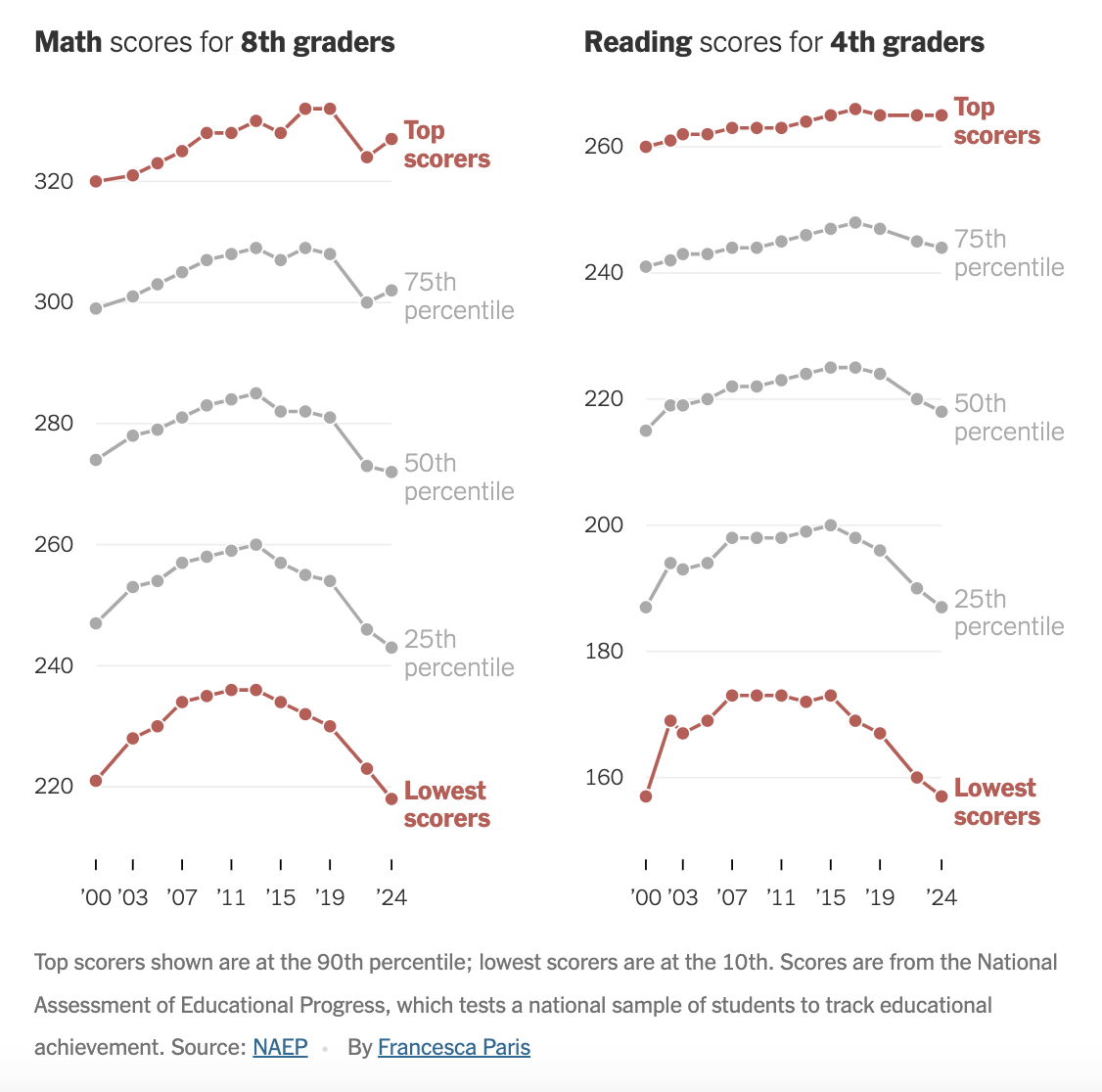
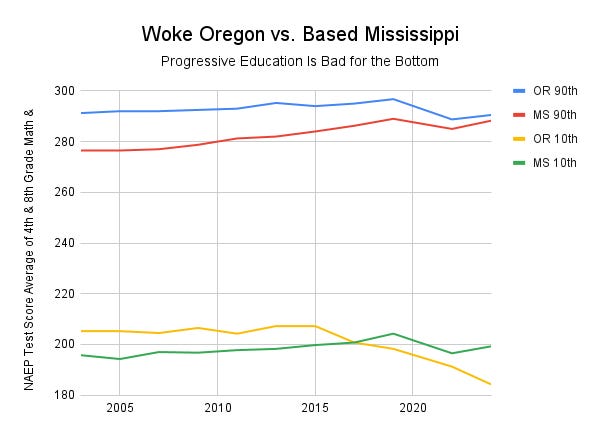

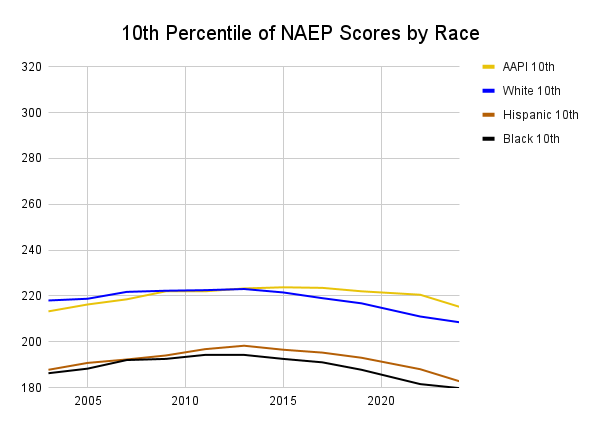
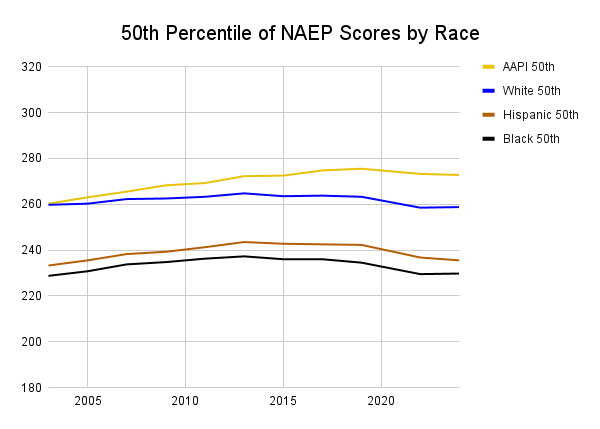
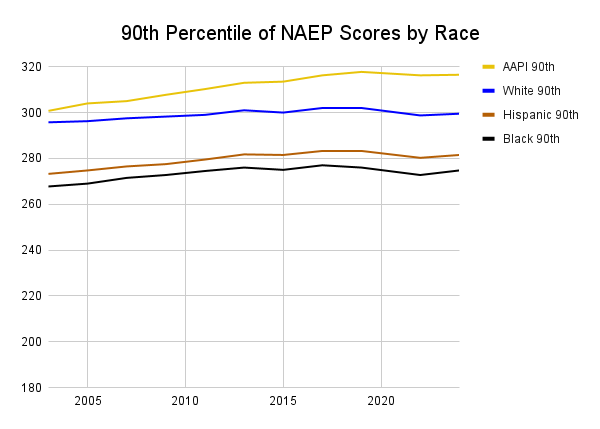
In short, Asians are grinds - and most students are unwilling to work that hard and most parents are not willing to push their kids that hard. My school district had a lot of highly educated South and East Asians. In general, their kids were reasonably smart and very hard working - and their parents tried hard to get their kids to study hard - and it showed. My kids Honors / IB classes were ~75% South and East Asian. Frankly, rather like when I grew up 50 years earlier on the East coast, when the honors classes were majority Jewish.
My daughter's comments was that her peers had Chinese Dragon mothers and Hindu Elephant mothers and she had an American Eagle father.
I let my kids know that they should get used to it, their peers in high school would likely be their peers in the workforce (I am in tech) and they had to work hard enough to compete effectively - which was quite hard. But we didn't do the Ivy status insanity - the kids headed to the University of Washington, my daughter by early admission, my son via Running Start. They both had their Masters before they turned 22 and both work in tech.
I was part of this project, teaching to the test. As a substitute teacher with an advanced Degree in History I was recruited to help teach tests in US history, government and civics. We went over the information in class and then after pre testing took the underperforming students into a remedial class with fewer students and more graphics than talk. In general, it worked. We improved enough on the tests that we got out of jail. Then it ended and now, 15 years later, the students are back to knowing little or nothing unless they are in AP classes. Our system is broken , perhaps never to recover.